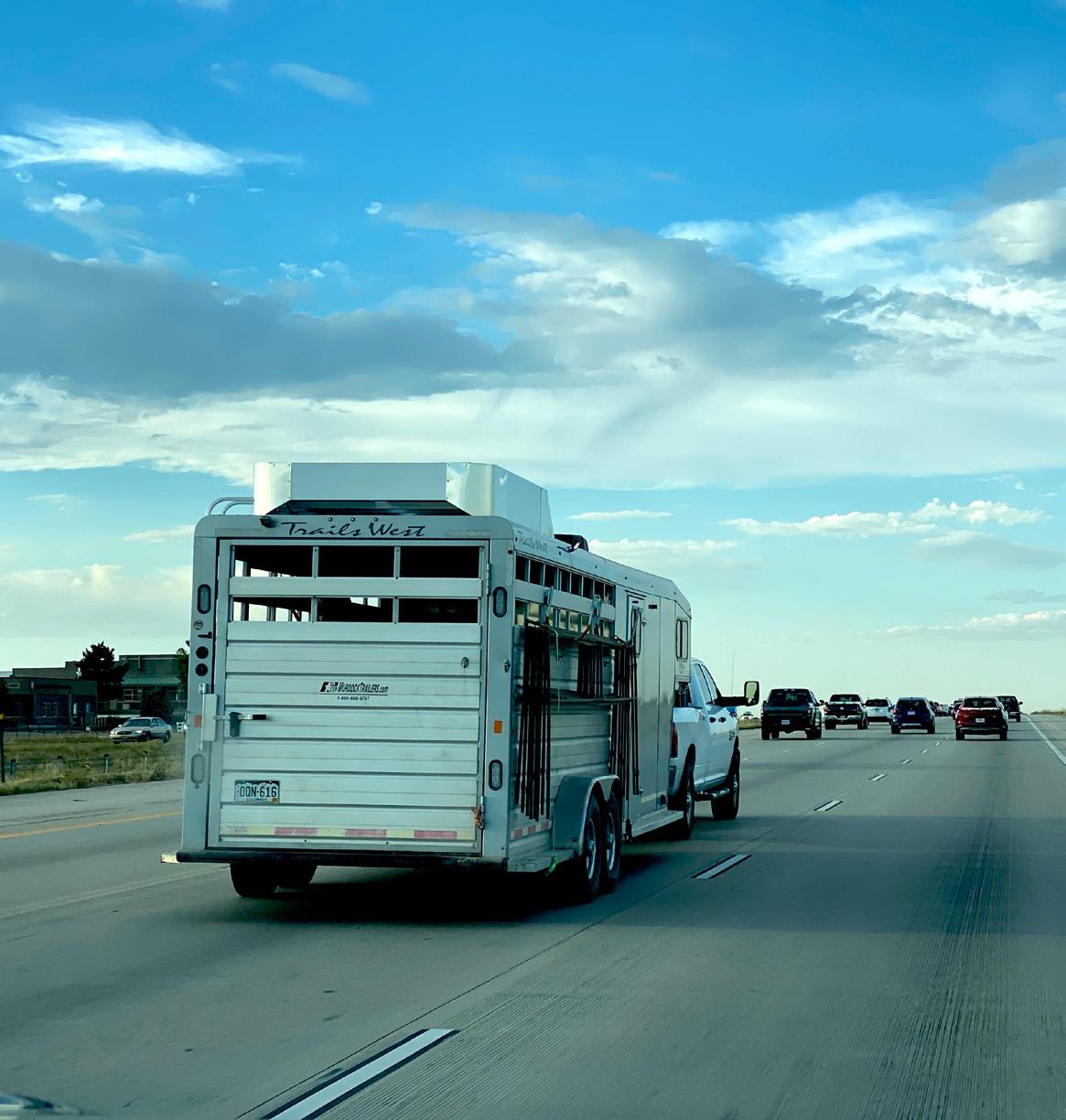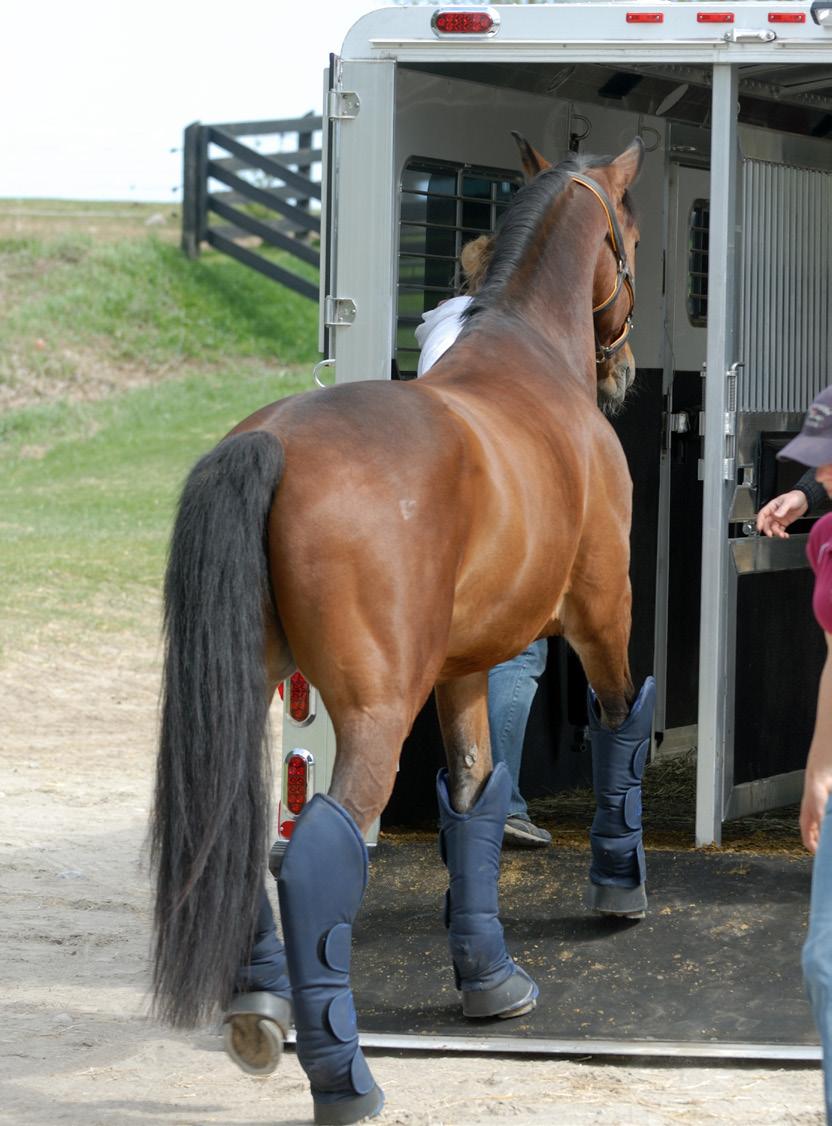
5 minute read
Skill Set
------------ SKILLSET------------
Enhance Your Horse’s Comfort
“Ack! What was that?” Calliope asked nervously of her trailer companion.
“It’s a chain banging over your head,” replied Zeus, an experienced traveler, as the two balanced carefully in the trailer. “They haven’t fixed it in years. They don’t realize that it’s scary and hurts our ears.”
The horses rode in silence for a few minutes. Then Calliope cried, “Ow! I hit my head!”
Zeus, his legs braced, nodded. “They hit the brakes too hard. You’ll learn this route to the trainer’s barn pretty quickly, so you can balance and brace yourself for potholes and stop signs.”
If horses could speak, did you ever wonder whether their conversations on the road would sound something like this?
Would your horse rate you highly as a conscientious, careful driver who made an effort to minimize his traumas and terrors?
Here, I’ll tell you how to find out exactly what your horse goes through when you haul him. Then I’ll give you a checklist to follow to make your trailer more quiet and comfortable.
Go For a Ride
The best way to understand your horse’s perspective while riding in your trailer is to simulate his experience. Leaving your horse behind, hitch your trailer to your tow vehicle, and ask an experienced rig handler to drive it around your property.
Oh, and be sure to stand in the back of your trailer with your hands tied firmly behind your back and without anything to lean on or use as support. And put on a blindfold, so you can’t see the upcoming stop signs, potholes, and sharp curves.
Of course, riding in your trailer is technically illegal and for a good reason—it’s dangerous. But if you safely perform this exercise while driving on private property, it’s a huge eye opener. You’ll discover exactly what your horse sees, hears, feels, and smells when riding in your trailer.
This exercise will demonstrate very clearly to you why you must regularly evaluate your trailer for environmental, structural, and engineering considerations. And you’ll improve your driving habits when you’re towing your most precious cargo.
It’s quite humbling to realize what your horse has to submit to as a wild prey animal entering a cave-like trailer.
Ask the driver to vary his or her driving—slow, fast, careful, reckless, easy brake, hard brake—over different types of surfaces, from smooth to bumpy.
With this learning experience, you’ll see why so many horses grow to balk at trailer-loading, and scramble and injure themselves inside of trailers while trying to balance.
PHOTO BY HEIDI MELOCCO Would your horse rate you highly as a conscientious, careful driver who made an effort to minimize his traumas and terrors?
Improve the Experience
Perform the following maintenance procedures to make your trailer a nicer travel environment for your horse. I call this my Sensory-Improvement Checklist. ■ Oil moving parts. Lubricate all jointed, hinged, or moving parts, such as springs, latches, hinges, and pins. This will help keep your trailer quiet. ■ Secure moving parts. With duct tape, secure all hanging chains or other moving parts that can squeak, bang, or clank. Many trailers are horrifically
>>
squeaky and boast loud metal-on-metal sounds you’ll never hear unless you check for them in motion. ■ Eliminate shadows. Look for horse-eating shadows and dancing light in odd places, such as a crack in the floorboards. Noted animal behaviorist Temple Grandin, PhD, has proven that weird shadows and light patterns can scare prey animals and prevent them from loading or walking forward. ■ Take a buddy. As a herd animal, horses tend to be calmer when hauled with a buddy instead of alone, especially young and fractious horses. Allow your horse to see some part of his buddy, but limit his ability to bite, kick, or crush his traveling companion. ■ Check the tires. Make sure that all the tires have the manufacturer’s recommended air pressure for maximum support and minimal friction on the road. Buy an air-pressure gauge, or have a tire professional check the tires for you. Optimal tire pressure will help make the ride smooth and quiet. ■ Maximize ventilation. Very few hauling scenarios require prevention of air moving over the horses. Provide as much ventilation as you can. Horses generate a great deal of heat, and very few trailers have sufficient ventilation, especially when stalled in traffic. Consider installing lightweight plastic fans or even air conditioning behind trailer stalls. Note that heat is rarely necessary. ■ Minimize dust. Minimize lightweight shavings and fluffy hay in your trailer. Anything that increases the dust blowing around and into your horse’s respiratory system will potentially compromise his health. For trailer bedding, consider commercial, bagged shavings. Wet your horse’s hay, even in the hay net. ■ Monitor the temperature. Install a wireless constant digital thermometer transmitter in your trailer at wither height (about five feet up the trailer wall, where horses can’t destroy it). Put the receiver in your vehicle. This allows you to constantly monitor the temperature that your horse is exposed to. ■ Check the headroom. Make sure that a standard-sized horse has at least 30 inches of room above his withers so he can raise and lower his head and neck to balance, and so he can clear his respiratory passages. If you must tie your horse in your trailer (and there are good reasons for doing so in many trailers), make sure he can lower his head at least to withers level. ■ Improve the stalls. Make sure your trailer provides enough room for your horse to position his legs forward and sideways to balance if you’re forced to turn or brake suddenly. Add thick padding to the dividers, chest and butt bars, and trailer walls at body height to minimize scratches—and worse. ■ Check for danger zones. Check for and fix any rusty, dangerous rough spots. Remove any metal pieces that could catch a halter— or an eyeball. Run your fingers along every edge (dividers, walls, gates, bars, etc.) where your horse might rub or bump, to reduce risk of injury. — Rebecca Gimenez Husted, PhD

PHOTO BY CLIXPHOTO.COM

PHOTO BY CLIXPHOTO.COM

PHOTO BY HEIDI MELOCCO Top: Be aware what your horse has to submit to as a wild prey animal entering a cave-like trailer. Middle: As a herd animal, horses tend to be calmer when hauled with a buddy instead of alone, especially young and fractious horses. Bottom: Provide as much ventilation as you can. Horses generate a great deal of heat, and very few trailers have sufficient ventilation, especially when stalled in traffic.










